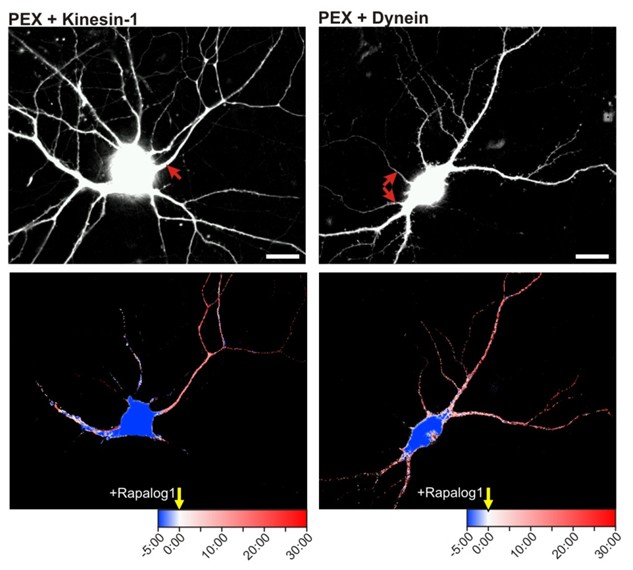Mixed microtubules steer dynein-driven cargo transport into dendrites. Kapitein LC, Schlager MA, Kuijpers M, Wulf PS, van Spronsen M, MacKintosh FC, Hoogenraad CC. Curr Biol. 2010 Feb 23;20(4):290-9. PMID: 20137950
To establish and maintain their polarized morphology, neurons employ active transport driven by molecular motors to sort cargo between axons and dendrites. However, the basic traffic rules governing polarized transport on neuronal microtubule arrays are large unknown. We now show that the microtubule minus-end-directed motor dynein is required for the polarized targeting of dendrite-specific cargo, such as AMPA receptors. To directly examine how dynein motors contribute to polarized dendritic transport, we established a trafficking assay in hippocampal neurons to selectively probe specific motor protein activity. This revealed that, unlike kinesins, dynein motors drive cargo selectively into dendrites, governed by their mixed microtubule array. Moreover, axon-specific cargos, such as presynaptic vesicle protein synaptophysin, are redirected to dendrites by coupling to dynein motors. Quantitative modeling demonstrated that bidirectional dynein-driven transport on mixed microtubules provides an efficient mechanism to establish a stable density of continuously renewing vesicles in dendrites. These results demonstrate a powerful approach to study specific motor protein activity inside living cells and imply a key role for dynein in dendritic transport. We propose that dynein establishes the initial sorting of dendritic cargo and additional motor proteins assist in subsequent delivery.
 Polarized redistribution of peroxisomes by Kif5 and dynein in hippocampal neurons
Polarized redistribution of peroxisomes by Kif5 and dynein in hippocampal neurons
(Top) Morphology of neuron expressing GFP, PEX-RFP-FKBP and Kif5-FRB (left) or BICDN-FRB (right), visualized by imaging GFP. Red arrows mark axons.
(Bottom) Overlay of sequential binarized images from the recording in B, color-coded by time. Red indicates regions targeted upon addition of rapalog1 (i.e. axon (left) or dendrites (right)).
